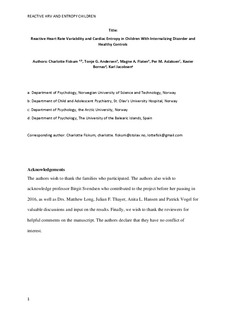| dc.contributor.author | Fiskum, Charlotte | |
| dc.contributor.author | Andersen, Tonje Grønning | |
| dc.contributor.author | Flaten, Magne Arve | |
| dc.contributor.author | Aslaksen, Per M | |
| dc.contributor.author | Bornas, Xavier | |
| dc.contributor.author | Jacobsen, Karl Henry | |
| dc.date.accessioned | 2020-03-13T08:58:26Z | |
| dc.date.available | 2020-03-13T08:58:26Z | |
| dc.date.created | 2019-09-03T14:26:52Z | |
| dc.date.issued | 2019 | |
| dc.identifier.citation | Applied Psychophysiology and Biofeedback. 2019, 44 (4), 309-319. | nb_NO |
| dc.identifier.issn | 1090-0586 | |
| dc.identifier.uri | http://hdl.handle.net/11250/2646660 | |
| dc.description.abstract | Atypical vagal reactivity has been linked to internalizing psychopathology and less adaptive emotion regulation, but reactive cardiac entropy is largely unexplored. Therefore, this study investigated reactive vagally-mediated heart-rate variability (vmHRV) and cardiac entropy in relation to emotion regulation. Electrocardiograms of 32 children (9–13 years) with internalizing difficulties and 25 healthy controls were recorded during a baseline and a sad film. Reactivity-measures were calculated from the root mean square of successive differences (RMSSD) and sample entropy (SampEn). Emotion regulation was assessed using the emotion regulation checklist (ERC). Determinants of reactive SampEn and RMSSD were analyzed with marginal and generalized linear models. The study also modeled the relationship between cardiac reactivity and emotion regulation while controlling for psychopathology. The two groups differed significantly in vmHRV-reactivity, with seemingly higher vagal-withdrawal in the control group. SampEn increased significantly during the film, but less in subjects with higher psychopathology. Higher reactive entropy was a significant predictor of better emotion regulation as measured by the ERC. Internalizing subjects and controls showed significantly different vmHRV-reactivity. Higher reactive cardiac entropy was associated with lower internalizing psychopathology and better emotion regulation and may reflect on organizational features of the neurovisceral system relevant for adaptive emotion regulation. | nb_NO |
| dc.language.iso | eng | nb_NO |
| dc.publisher | Springer | nb_NO |
| dc.title | Reactive Heart Rate Variability and Cardiac Entropy in Children with Internalizing Disorder and Healthy Controls | nb_NO |
| dc.type | Journal article | nb_NO |
| dc.type | Peer reviewed | nb_NO |
| dc.description.version | acceptedVersion | nb_NO |
| dc.source.pagenumber | 309-319 | nb_NO |
| dc.source.volume | 44 | nb_NO |
| dc.source.journal | Applied Psychophysiology and Biofeedback | nb_NO |
| dc.source.issue | 4 | nb_NO |
| dc.identifier.doi | 10.1007/s10484-019-09444-0 | |
| dc.identifier.cristin | 1721069 | |
| dc.description.localcode | This is a post-peer-review, pre-copyedit version of an article published in [Applied Psychophysiology and Biofeedback] Locked until 12.7.2020 due to copyright restrictions. The final authenticated version is available online at: https://doi.org/10.1007/s10484-019-09444-0 | nb_NO |
| cristin.unitcode | 1920,18,0,0 | |
| cristin.unitcode | 194,67,40,0 | |
| cristin.unitname | PH - Barne- og ungdomspsykiatrisk klinikk | |
| cristin.unitname | Institutt for psykologi | |
| cristin.ispublished | true | |
| cristin.fulltext | original | |
| cristin.qualitycode | 1 | |
